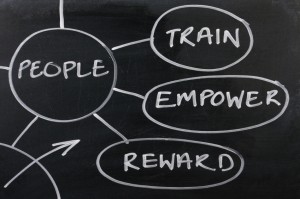This article, for Human Resource staff and workplace managers, was written by Michelle Garcia Winner, MA, CCC-SLP, and Pamela Crooke, Ph.D., CCC-SLP, authors of Social Thinking at Work: Why Should I Care?
 Everyone knows someone who can be said to have good or bad social skills. As a Human Resources professional, you may have been tasked to talk, yet again, with the brilliant but odd employee who just doesn’t seem to know how to act appropriately during meetings. Or to the new hire who repeatedly monopolizes her boss’ time with her personal problems. As a manager responsible for a department of employees, you may be able to easily spot those staff who work well in a group, get along with everyone (even those who try your patience), and are liked by all. And, you can probably just as easily identify those whose work performance is top-notch, yet the rest of the team doesn’t seem to want to work with them. How can you help those struggling staff members better “fit in” and understand how to act? The answer lies in starting at the source: social thinking.
Everyone knows someone who can be said to have good or bad social skills. As a Human Resources professional, you may have been tasked to talk, yet again, with the brilliant but odd employee who just doesn’t seem to know how to act appropriately during meetings. Or to the new hire who repeatedly monopolizes her boss’ time with her personal problems. As a manager responsible for a department of employees, you may be able to easily spot those staff who work well in a group, get along with everyone (even those who try your patience), and are liked by all. And, you can probably just as easily identify those whose work performance is top-notch, yet the rest of the team doesn’t seem to want to work with them. How can you help those struggling staff members better “fit in” and understand how to act? The answer lies in starting at the source: social thinking.
When most people are asked to define what it means to use good social skills, they may say it means being polite or getting along with people. When you dig a little deeper, typically they will say it includes eye contact, reciprocal interaction, respecting other people’s space, listening and responding with a related comment, reading nonverbal cues, and trying to understand the other speaker’s point of view.
While all of these may be true, we are expected to use good social skills not just when we’re in conversation with others. Think of a board meeting or a conference, where most people are relegated to the role of listener. As listeners we still need to use our social skills. In fact, not talking is what is expected in that environment, and being able to sit quietly while looking in the direction of the speaker is the desired, or good, social behavior.
How we behave depends not only on the people we are with, but also on the hidden rules embedded in different environments or situations. For example, the types of comments made or jokes told when the CEO is present at a company meeting are very different from the jokes or comments we hear when we go out for a drink with coworkers at the end of the day. The social context actively feeds us information about how to regulate our social behavior.
The use of good social skills, then, is more about social expectations for particular situations. This involves being aware of the presence of others and adjusting our behavior based on what people are thinking (or what we want them to think) even in the absence of spoken communication. Interestingly, having good social skills does not mean always “acting nice.” Social skills can be used to discourage interaction, too. When we are busy at work and don’t have time for small talk, we discourage interaction by walking past someone and not stopping to chat.
Combine all this information together, and what emerges is a broader definition of good social skills as the ability to effectively adapt our social behavior around others according to the situation, what we know about the people in that situation, and our own existing needs.
Thinking About Thinking Socially In our efforts to help employees with less-than-stellar social skills, the first thing to appreciate is that our social abilities are not skill-based—they are thinking based. The end result—the behavior—is predicated by first using our brains to decipher the situation based on clues from the environment and then formulate a response. In other words, good social skills first start with good social thinking.
Because our social skills are based largely on this core concept of social thinking, people painted as having good or bad social skills really can be better described as having stronger or weaker related social thinking. “Social thinking”—a term coined by speech-language pathologist Michelle Garcia Winner—is how we think about our own and others’ minds. To improve our social performance, we must first hone our ability to figure out what other people are thinking. To do this, we have to study how our own social mind works.
We all have thoughts about others we share space with: positive thoughts, negative thoughts, and neutral thoughts. Sharing space refers to any time we’re aware we are in the presence of another person—in a parking garage, in a bathroom, or at a board meeting, for example. Furthermore, like it or not, we are all emotional beings, often navigating our smallest movements in the presence of others simply to guide their emotional response to us. Although this phenomenon is something we rarely put into words, our strongest memories of people come from how they tipped our emotional scale, whether positively or negatively. Few of us remember, months or years later, exactly what someone said to make us feel good or bad, but our social memories have strong emotional footprints. The person we remember liking is the one who made us feel good, while the person we think we disliked is whoever made us feel bad—or just uncomfortable.
Social thinking tells us that sometimes it is more important to make decisions based on how we make people feel rather than on group efficiency. To get along within a social environment, such as an office or a corporation, we have to adapt our social thinking and related social skills to be sensitive to the different people we encounter in a range of situations, regardless of whether we interact with them directly or not.
Pay attention each time you are in the presence of others. Consider how you adapt your behavior when you are in shared space. For instance, you might take a step forward to allow someone to move around you; otherwise he may think you are rude, or at least not considering his needs. Or you may sense a colleague needs some assistance and offer to help, even when there’s no direct verbal request to do so.
No single set of rules governs social behavior across the work or leisure day. The art and skill of the social mind involves figuring out in the moment how to adapt socially to the situation, the person or the culture—and like any other aspect of our minds, it can develop and change with the proper tools to explore it. Professionals who take on the role of manager or advisor in the workplace can benefit from learning more about social thinking and the pivotal role it plays as a precursor to social behavior. When individuals struggle with social skills, it is not enough to only address the behavior. To be effective in helping these individuals, conversation needs to start at the roots—at the social thinking level.
About the Authors
Michelle Garcia Winner is a Congressional award-winning speech language pathologist, clinician, prolific author, and international speaker who coined the term “social thinking” in the mid-1990s and developed a Social Thinking treatment method for children and adults.
Pamela Crooke is a speech language pathologist, a senior therapist at Winner’s San Jose, CA treatment clinic, the Social Thinking Center, and is part of the faculty at San Jose State University.
Written for the adult who has trouble deciphering the social code of the workplace, Social Thinking at Work: Why Should I Care? is a primer about the inner workings of the social mind while on the job. It teaches core concepts of how we think about our own and others’ thoughts and emotions, and how social thinking is pivotal to achieving success in any environment. Excellent for HR personnel and corporate managers to better understand social thinking across the work day.






